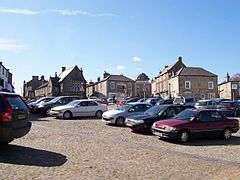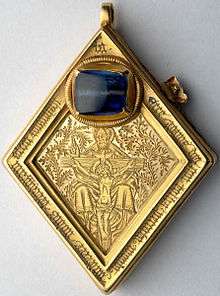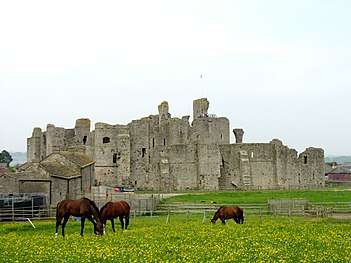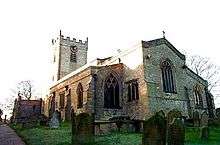Middleham
Middleham /ˈmɪdləm, -dələm/[2] is a small English market town and civil parish in the Richmondshire district of North Yorkshire. It lies in Wensleydale in the Yorkshire Dales, on the south side of the valley, upstream from the junction of the River Ure and River Cover. There has been a settlement there since Roman times. It was recorded in the 1086 Domesday Book as "Medelai", i.e. "middle ham or village".
| Middleham | |
|---|---|
 Middleham Marketplace | |
 Middleham Location within North Yorkshire | |
| Population | 825 (2011 census)[1] |
| OS grid reference | SE124878 |
| District | |
| Shire county | |
| Region | |
| Country | England |
| Sovereign state | United Kingdom |
| Post town | LEYBURN |
| Postcode district | DL8 |
| Dialling code | 01969 |
| Police | North Yorkshire |
| Fire | North Yorkshire |
| Ambulance | Yorkshire |
| UK Parliament | |
History
The first known settlement came in the Roman period. The IXth Roman Army Legion conquered York in AD 69 and moved north. A branch road from the extension of Ermine Street passed through to the Roman fort at Bainbridge. Nearby the Romans built a guard station on the River Ure.[3]
Before the Norman Conquest, the lands around were controlled by Gilpatrick. In 1069, William the Conqueror granted them to his Breton cousin Alan Rufus, who built a wooden motte-and-bailey castle above the town. By the time of the 1086 Domesday Book, Alan had passed the castle to his brother Ribald. Its earthworks are still visible at William's Hill. Alan also built the castle at Richmond.
Construction of the castle that still dominates the town, Middleham Castle, began in 1190. The Nevilles, Earls of Westmorland, acquired it through marriage to a female descendant of Ribald in the 13th century. It has been dubbed the "Windsor of the North". The castle belonged to Richard Neville, 16th Earl of Warwick when his cousin Richard, Duke of Gloucester (the future Richard III) came there to learn knighthood skills in 1462. During the Wars of the Roses, both Edward IV and Henry VI were held prisoner there. Richard, Duke of Gloucester, became master of the castle in 1471 after Warwick's death at the Battle of Barnet. He used it as his political base for ruling the North on behalf of his brother Edward IV. Richard married Warwick's daughter, Anne Neville, in 1472. Middleham Castle is where their son Edward was born in about 1473 and died in April 1484. Richard III, who died in August 1485 at the Battle of Bosworth, was the last reigning King of England to perish in battle.[4]
Under Richard III, Middleham was a bustling market town and political centre.[5] In 1389, the Lord of Middleham Manor received a crown grant to hold a weekly market and yearly fair on the feast of St Alkelda the Virgin.[6] The town has market places: the larger, lower one is dominated by a medieval cross, topped by a modern iron cross in Celtic style. The upper or swine market centres on the remains of a 15th-century market cross and a line of steps. At one end of the cross is a worn effigy of an animal reclining; the other may have had a moulded capital.
Most buildings in old parts of Middleham predate 1600; the old rectory incorporates some medieval features.[7] In 1607 Middleham was important enough for a royal court covering residents of the forest of Wensleydale.[8] Middleham and surrounding lands were part of the Crown estates from the accession of Richard III until Charles I sold the manor to the City of London in about 1628.[9] In 1661 the City of London sold Middleham Manor to Thomas Wood of Littleton; it has remained in private hands to this day.[10] In 1915 the annual livestock market was still regionally important but the weekly market had been discontinued. Today's livestock market is in Leyburn.
Parish church
The Church of Saints Mary and Alkelda was founded in 1291. Its mainly 14th and 15th-century architecture includes some stones that indicate the presence of a church on the site perhaps a century before.[7] The only remaining Norman artefact is a section of zig-zag moulding that once surrounded a door or window and now appears above the north aisle. The church has a three-metre Perpendicular font cover and a replica of the Middleham Jewel, found locally. West of the church is St Alkelda's well, whose waters were said to restore weak eyes.
In 1478 Edward IV gave permission for a leper hospital to be built on the east side of town, in association with the church. Its location, Chapel Fields, is now given over to a horse-training stables. No trace of a hospital or chapel remains.[3]
Middleham today
Today the town is a centre of horse racing and home to Middleham Trainers' Association. The first racehorse trainer at Middleham was Isaac Cape in 1765. Today there are several, including Mark Johnston, Jedd O'Keefe, James Bethell, and Ben Haslam. Racing is the foremost employer in the town and tourism the second. The castle is a ruin, having been dismantled in 1646, but the keep, built by Robert Fitz Ralph in the 1170s, survives, as do the 13th-century chapel and 14th-century gatehouse.
Governance
An electoral ward of the same name exists stretching south-west to Melmerby. Its population recorded in the 2011 census was 1,284.[11]
Middleham Jewel

In 1985 the Middleham Jewel was found on a bridle path near Middleham Castle by Paul Kingston and Ted Seaton using a metal detector.[12] It has since been acquired by the Yorkshire Museum in York for £2.5 million. It is a late 15th-century 68-gram gold pendant with a 10-carat blue sapphire stone. The pendant is a lozenge, engraved on the obverse with a representation of the Trinity, bordered by a Latin inscription warding off the evil of epilepsy.[13] The reverse has a decorative engraving of the Nativity, bordered by the faces of 13 saints.[14]
The back panel slides to reveal a hollow interior, which originally contained three-and-a-half tiny discs of silk embroidered with gold thread.[14] The textile contents identify the jewel as a reliquary, containing a fragment of reputed holy cloth. It would have been worn by a lady of high social status as the crest for a large necklace.[12] The sapphire may represent Heaven,[15] and have acted as an aid to prayer.
Archaeological discoveries
Other notable finds from Middleham include:
- The Middleham Hoard – three pots containing 5,099 silver coins in total buried in the English Civil War – is the largest such hoard discovered.[16]
- A livery badge for pinning to the chest or a hat, in gilded copper high relief, with Richard III's emblem of a white boar, is likely to have been worn by one of his household, when he was Duke of Gloucester.[17]
- The Middleham ring in the Yorkshire Museum, found in 1990 is a gold ring decorated with a low-relief inscription along the band reading SOVEREYNLY.[18]
- A circular, copper-alloy plaque (3-inch (70 mm) diameter) bearing the initials "R" and "A" surrounded by the French motto A Vo. Plaisir (For your pleasure) may be a casket mark given by Richard, Duke of Gloucester to his wife Anne.[19]
Geography and geology
The town lies between 400 and 500 feet (120 and 150 m) above ordnance datum. The valley of the River Ure below the town has an altitude of 325 feet (99 m) and the summit of the hill to the south-west of the town 850 feet (260 m). The parish contains 2,155 acres (8.72 km2) of land, mostly permanent pasture – only about 150 acres (0.61 km2) is arable. The topsoil is mixed. The valley has modern alluvial terraces and gravel deposits, but the subsoil is mainly limestone, although intersected here and there by sandstone with plate. There is a known vein of lead in the northern part of the parish. Braithwaite lead mine lies just outside the parish borders.[7]
Notable people
In birth order:
- Anne Neville (1456–1485), consort of King Richard III of England, spent most of her childhood at the castle.
- Edward of Middleham, Prince of Wales (1473–1484) was born and died at the castle.
- Tobias Pullen, religious controversialist and Church of Ireland bishop, was born in the town in 1648.
- John Baynes, miscellanist and lawyer, was born in the town in 1758.
- Job Marson (1817–1857), the celebrated jockey, died at Middleham.
Popular culture
Middleham appeared three times in the UK television series All Creatures Great and Small. The episode "Against the Odds" had the Manor House as the home of the Barraclough family.[20] In the episode "Where Sheep May Safely Graze", Middleham Antiques, in North Road, became Geoff Hatfield's confectionery shop.[21] Ferndale became the home of the Darnley sisters in the episode "The Rough and the Smooth".[22]
Twin towns
Middleham is twinned with:
References
- UK Census (2011). "Local Area Report – Middleham Parish (1170217169)". Nomis. Office for National Statistics. Retrieved 21 February 2018.
- Jones, Daniel (2006). Roach, Peter; Hartman, James; Setter, Jane (eds.). English Pronouncing Dictionary (17th ed.). Cambridge University press. p. 324. ISBN 978-0-521-86230-1.
- "A Pilgrimage to Middleham and Richard's North Country". cogeco.ca. Archived from the original on 14 December 2014. Retrieved 13 December 2014.
- "Middleham Castle". middlehamonline.com. Retrieved 13 December 2014.
- Weaver, John (1993). Middleham Castle. London: English Heritage. p. 31. ISBN 1-85074-409-2.
- Chart. R. 11–13 Ric. II, m. 21; cf. Cal. Pat. 1436–1441.
- A History of the County of York North Riding: Volume 1, William Page, ed., 1914.
- Exch. Dep. Mich. 5 Jas. I, no. 8. The earliest lords claimed the forest of Wensleydale by inheritance (Pipe R. 4 John [Yorks.]; Abbrev. Plac. [Rec. Com.], 74; Coram Rege R. Mich. 12 Hen. III).
- Pat. 4 Chas. I, pt. xxxiii, Roll B.; Cal. Com. for Comp. 2444; Exch. Dep. East. 13 Chas. II, no. 15.
- N. and Q. September 1884; Whitaker, Richmondshire.
- UK Census (2011). "Local Area Report – Middleham 2011 Census Ward (1237325139)". Nomis. Office for National Statistics. Retrieved 21 February 2018.
- Cherry 1994, pp. 16–17.
- "Middleham Jewel". Art Fund. 11 June 2013. Retrieved 11 June 2013.
- Cherry 1994, pp. 24–26.
- Cherry, John. The Holy Thorn Reliquary, p. 7, 2010, British Museum Press (British Museum objects in focus), ISBN 0-7141-2820-1
- Barclay, Craig (1994). "A Civil War Hoard from Middleham, North Yorkshire" (PDF). British Numismatic Journal. 64 (8): 84–98.
- John Cherry (2003), in Richard Marks and Paul Williamson, eds., Gothic: Art for England 1400–1547, p. 204, no. 69, 2003, V&A Publications, London. ISBN 1-85177-401-7
- Cherry 1994, pp. 10–11.
- Cherry 1994, p. 40.
- "Manor House, West End, Middleham, N Yorks, UK – All Creatures Great & Small, Against The Odds (1988)". Waymarking.com. Retrieved 17 September 2013.
- "North Rd, Middleham, N Yorks, UK – All Creatures Great & Small, Where Sheep May Safely Graze (1989)". Waymarking.com. Retrieved 17 September 2013.
- "Ferndale, Middleham. N Yorks, UK – All Creatures Great & Small, The Rough & The Smooth (1989)". Waymarking.com. Retrieved 17 September 2013.
- "British towns twinned with French towns [via WaybackMachine.com]". Archant Community Media Ltd. Archived from the original on 5 July 2013. Retrieved 20 July 2013.
Sources
- Cherry, John (1994), The Middleham Jewel and Ring, Yorkshire Museum (York)
External links
| Wikimedia Commons has media related to Middleham. |

